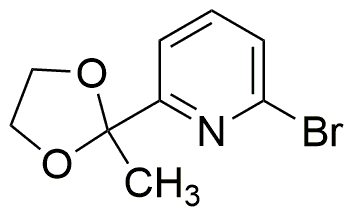2-Bromo-6-(2-methyl-1,3-dioxolan-2-yl)pyridine is widely utilized in research focused on:
- Synthetic Organic Chemistry: This compound serves as a versatile building block for synthesizing various complex organic molecules, enabling researchers to develop new pharmaceuticals and agrochemicals.
- Pharmaceutical Development: It plays a crucial role in drug discovery, particularly in the creation of compounds with potential therapeutic effects, enhancing the efficiency of medicinal chemistry.
- Material Science: The chemical is used in the development of advanced materials, including polymers and coatings, which benefit from its unique properties, improving durability and performance.
- Biochemical Research: It is employed in studies related to enzyme activity and receptor binding, helping scientists understand biological processes and develop targeted therapies.
- Environmental Chemistry: The compound is investigated for its potential applications in environmental remediation, particularly in the breakdown of pollutants, contributing to cleaner ecosystems.
Informations générales
Propriétés
Sécurité et réglementation
Applications
2-Bromo-6-(2-methyl-1,3-dioxolan-2-yl)pyridine is widely utilized in research focused on:
- Synthetic Organic Chemistry: This compound serves as a versatile building block for synthesizing various complex organic molecules, enabling researchers to develop new pharmaceuticals and agrochemicals.
- Pharmaceutical Development: It plays a crucial role in drug discovery, particularly in the creation of compounds with potential therapeutic effects, enhancing the efficiency of medicinal chemistry.
- Material Science: The chemical is used in the development of advanced materials, including polymers and coatings, which benefit from its unique properties, improving durability and performance.
- Biochemical Research: It is employed in studies related to enzyme activity and receptor binding, helping scientists understand biological processes and develop targeted therapies.
- Environmental Chemistry: The compound is investigated for its potential applications in environmental remediation, particularly in the breakdown of pollutants, contributing to cleaner ecosystems.
Documents
Fiches de données de sécurité (FDS)
La FDS fournit des informations de sécurité complètes sur la manipulation, le stockage et l’élimination du produit.
Spécifications du produit (PS)
Le PS fournit une description complète des propriétés du produit, notamment sa composition chimique, son état physique, sa pureté et les exigences de stockage. Il détaille également les plages de qualité acceptables et les applications prévues du produit.
Certificats d'analyse (COA)
Recherchez des certificats d'analyse (COA) en saisissant le numéro de lot du produit. Les numéros de lot et de lot se trouvent sur l'étiquette d'un produit, après les mots « Lot » ou « Lot de fabrication ».
Numéro de catalogue
Numéro de lot/série
Certificats d'origine (COO)
Ce certificat d'exploitation confirme le pays dans lequel le produit a été fabriqué, et détaille également les matériaux et composants utilisés et s'il est issu de sources naturelles, synthétiques ou autres sources spécifiques. Ce certificat peut être requis pour les douanes, le commerce et la conformité réglementaire.
Numéro de catalogue
Numéro de lot/série
Fiches de données de sécurité (FDS)
La FDS fournit des informations de sécurité complètes sur la manipulation, le stockage et l’élimination du produit.
DownloadSpécifications du produit (PS)
Le PS fournit une description complète des propriétés du produit, notamment sa composition chimique, son état physique, sa pureté et les exigences de stockage. Il détaille également les plages de qualité acceptables et les applications prévues du produit.
DownloadCertificats d'analyse (COA)
Recherchez des certificats d'analyse (COA) en saisissant le numéro de lot du produit. Les numéros de lot et de lot se trouvent sur l'étiquette d'un produit, après les mots « Lot » ou « Lot de fabrication ».
Numéro de catalogue
Numéro de lot/série
Certificats d'origine (COO)
Ce certificat d'exploitation confirme le pays dans lequel le produit a été fabriqué, et détaille également les matériaux et composants utilisés et s'il est issu de sources naturelles, synthétiques ou autres sources spécifiques. Ce certificat peut être requis pour les douanes, le commerce et la conformité réglementaire.


